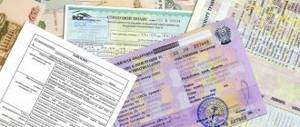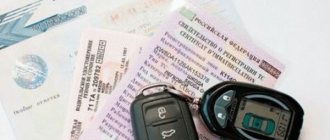What does duplicate PTS mean?
A duplicate vehicle passport (PTS) is an official document that is issued by the State Traffic Safety Inspectorate indicating the reason for issuance and the details of the original.
A duplicate PTS is issued to the car owner in two cases. The first is when there is no free space to enter new information (the columns have run out).
The original document has 6 fields for filling in information about the owner of the car. At first glance, it seems that there are a lot of fields, and there are more than enough of them even to resell the car several times. However, this opinion is wrong.
Let's explain with an example. The first owner of the vehicle is the manufacturer, then the car is sent to the dealership for sale. And 2 fields have already been filled, although the iron horse did not even have time to reach the hands of the car enthusiast. There are also frequent cases when a car wanders from one salon to another, waiting for the time of operation. These are a couple more filled-in boxes.
Also, when changing the owner’s last name, first name or patronymic, this information is indicated in the PTS. Thus, the car can only be used by one person, and there will no longer be any free space in the vehicle passport.
The second case is the loss or theft of a document. This is another reason why vehicle owners contact the traffic police. In this situation, future buyers of used cars should be careful. In this article, Autocode will tell you how to prevent problems that can result from buying a car with a duplicate title.
Why is a duplicate PTS dangerous?
First of all, you should understand what a duplicate PTS is and in what cases it can be issued for a car. Experts say that the issuance of a duplicate is carried out by traffic police officers in the event of damage, loss, or absence of free fields in the original for entering information about the new owner. The document has the same degrees of protection as the original. It is equipped with holograms and traffic police stamps.
But, despite this, most experienced motorists avoid purchasing vehicles whose owners present a duplicate and not the original title. Let's try to figure out what is the reason for the buyer's mistrust. There may be several of them:
The absence of the original PTS may indicate the presence of an encumbrance. It is worth considering if the car has low mileage, the year of manufacture does not exceed 3-5 years and the price is an order of magnitude lower than that of similar models. In this case, there is a high risk of becoming the owner of a credit car, the original title of which is pledged to the bank. Perhaps the former owner does not plan to repay the loan anymore and therefore they ordered a duplicate document for the illegal sale of the car. As soon as the bank stops receiving monthly payments and cannot find a borrower, it will petition the court to confiscate the vehicle.- A large number of owners. If their number exceeds 6 people, then the traffic police issues a duplicate PTS. Such a rapid change of owners should suggest the reason for the rapid sale of the car after purchase. Perhaps the car has a number of defects that make such a purchase very doubtful.
- Interrupted body or engine numbers. This is what they do with cars that are wanted after being stolen. It will not be possible to register this vehicle. After all, the numbers in the duplicate PTS will not match the engine and body data.
- The purchased vehicle was deregistered due to its disposal. You can avoid such an acquisition by carefully studying the information posted in the duplicate PTS. It is important to understand that if this mark is present, then it is simply impossible to register the car with the traffic police. An insurmountable obstacle is that the former owner has already received a certain amount for the car under the recycling program. And it is simply not in the traffic police database.
- The likelihood of becoming the owner of a “constructor”. Often, scammers buy cars after a fire, restore them using parts found at disassembly sites and sell them to naive buyers.
Attention
But we should not forget that the former owner could become a victim of fraudsters or, due to his negligence, lose the original title of the car. In this case, a duplicate document will only indicate that the original was lost or damaged. An honest car seller immediately points out the reasons for receiving a duplicate title.
What a duplicate PTS looks like: how to distinguish a duplicate PTS from the original
A duplicate of a car passport is made on the same paper as the original. To the touch it resembles the material of banknotes.
If you move your eyes from top to bottom along the front side of the document, first you will come across a large inscription “DUPLICATE”, and then - the stamp of the traffic police (instead of the stamp of the manufacturer or customs authority, which is present on the original). On the other side there must be a special mark indicating the reason for issuing the duplicate. For example, “... due to the disposal of the original.”
When is a duplicate issued?
The absence of a vehicle on the wanted list, arrest or alienation presupposes the issuance of the mentioned document in the following cases:
- lack of free space in the unit’s passport due to the large number of records about former owners;
- damage or loss;
- change of owner;
- change of place of residence even within the same locality.
In the first case, the former owner of the car remains with a copy of the original - a doublet, which can be used to check the number of owners and the history of the vehicle.
When purchasing a used car and holding a duplicate of the transport license in your hands, you should ask about the reason for its replacement and carefully study the copy. The name of the institution that issued the PS is always indicated on the first page. If there is a mark from the traffic police department, the buyer should understand that this is a doublet.
The basis for issuance of this type is invariably indicated by special marks; their options can vary significantly. If a duplicate is issued due to the disposal of the original, it means that the original has deteriorated in appearance, has been lost or there are no free fields to be filled in about the owner. Of course, the latter should suggest that the car has had many owners. But the traffic police mark confirms this, and therefore it will be difficult to deceive the buyer by claiming that the car is new.
If there is a mark about the loss of the original, and it is also very recent, then the buyer needs to keep his ears open - it is possible that this is a fraud. Before this, the unit could have had a dozen owners, or it could have been operated by some enterprise where the driver was not endowed with conscience or frugality in relation to his workplace. After all, the document will only indicate the previous owner - the seller, who is verbally trying to update the product. But that's not all.
Having issued a car loan, the bank pays for the car, while retaining the passport of the technical unit. This serves as a guarantee to the financial institution that the borrower will not disappear without a trace with his car. But the bank client may run out of money that he paid for the car, and it is impossible to sell it to another person without a registration certificate.
Then the bankrupt goes to the next trick - he allegedly loses his passport and receives a doublet at the traffic police department. The traffic police have no time to figure out whether the document was really lost or is in the bank until the loan is repaid. It makes no difference to the financial institution who bought the car or makes contributions. The credit institution simply confiscates the car, regardless of the owner, even if it is new. A court decision to return the money may also yield nothing - the seller turned out to be completely bankrupt.
The next episode may be that the vehicle is sold by an intermediary, who, of course, does not register the unit in his name. The current remedy can be fined many times, and the buyer, by taking it for himself, assumes all his debts. The only way to avoid unnecessary costs is to convince the intermediary to register the car in your name. However, if the fines are not paid, the car will not be registered with the traffic police. This will be confirmed by the traffic police portal, where you can find out the registration history of this device.
What to be afraid of when buying a car with a duplicate title
If the buyer is going to buy a car with a non-original title, he should make sure that the seller is not a fraudster.
There are several fraudulent schemes in the modern market for buying and selling used cars. One of the most popular is the sale of credit cars. Criminals buy a vehicle on credit secured by a title. Next, they contact the traffic police department with a request to restore the lost vehicle passport. And based on the legal owner, a duplicate is made in the name of the fraudster. He sells the loan car, thereby transferring all loan obligations to the new owner.
The second way to deceive buyers is to sell a car that is the subject of property disputes. In this case, the original PTS is in the possession of one person, and the car is in the possession of another. The fraudster contacts the traffic police, receives a non-original document and sells the car on the secondary market. Even after the sale of the vehicle, it does not cease to be the object of a property dispute, therefore, after the trial, the new owner will have to give the car back, even if he is a bona fide purchaser. In 98% of cases, the court sides with the real owner of the car.
Law on purchasing a car with a duplicate title
The legislative framework of the Russian Federation contains a number of documents that regulate the need to obtain a duplicate of the PTS to replace the lost original. Such regulations include:
- Order of the Ministry of Internal Affairs of Russia 496 Section 1 Part 10.
- Resolution of August 12, 1994 No. 938 part 3.
- Order of the Ministry of Internal Affairs No. 605.
Strictly observing the instructions of these regulations, vehicle owners are required to register vehicles in a timely manner and have an original or duplicate of the technical vehicle passport in their hands.
How to check a duplicate PTS
Today, a person who wants to buy a used car can easily find a photo of a duplicate title on the Internet. From the photograph and description provided earlier, you can easily find the most obvious signs of differences.
However, immediately obvious differences do not guarantee the authenticity of a document. Autocode will tell readers how to distinguish the original from the fake.
- Checking the authenticity of the paper. A duplicate of the PTS is made using watermarks and holograms. The document also contains three-dimensional images.
- Check to retrieve information about the old owner of the car. If fraudsters tried to write any inscriptions on a duplicate, the letters will still remain on the paper. In this case, hold the document up to the light and look at it; the old information will be visible through the sheet of paper.
- Compliance of the information indicated on the document with the vehicle being sold. The information includes the make, model and color of the iron horse, engine size, weight, production date, chassis number. You can see some parameters yourself under the hood, while others will only be determined in a car service center, for example, the weight of the car.
Online check
If a person does not have the opportunity to personally visit the nearest traffic police department and submit a written application for a vehicle inspection, then you can use the online service. To check the authenticity of a duplicate PTS when purchasing a car, you need to follow a simple algorithm:
- Go to the official website of the traffic police.
- Select the “Services” section.
- Then click on the “Vehicle Check” link.
- Enter the VIN number/chassis data in the window that opens and send it for verification.
- Wait for the result.
- The resulting result contains information about the participation of the car in an accident, the number of owners, color, make and model of the vehicle.
For your information
, using the traffic police database allows you to check whether the purchased car with a duplicate title has passed through the recycling program and is not wanted in connection with theft. Due to the fact that the site contains a single database, you can get information on a car registered in any region of the Russian Federation.
What does a duplicate look like?
Almost any document can be lost or become unusable, and a duplicate is issued in its place. A similar thing can happen with the technical equipment passport. The owner will also receive an official registered copy.
This document is a strict reporting form with continuous numbering. In appearance, the repeated PTS is no different from the original one, the same blue paper and the same manufacturer - Goznak. Only the first one has a specific entry in the “Special Notes” section. It is indicated by the inscription: “Duplicate. Issued to replace the old PTS”, below are the details of the original.
The official copy contains all 24 sections, which indicate:
- VIN number of the unit;
- car make, model;
- body type;
- information about the engine, unit weight;
- Manufacturer country;
- information about the owner of the unit.
Confirms the recorded seal and attributes of the institution issuing the doublet.
The duplicate is the same official document. A duplicate PTS is issued instead of the lost original if it is lost, damaged or there are no free fields to record information about the owner. Contains watermark protection and the inscription “DUPLICATE” in large font.
How to distinguish an original from a duplicate
The issued doublet, for whatever reason, is no different in appearance from the original.
Both of them indicate the presence of a vehicle officially registered with the traffic police. Any certificate has continuous numbering and series, an identical paper background, and filigree. In a word, they are equivalent. Their difference is observed only in the “Special Marks” section, where there is a rectangular stamp with the letters “Duplicate” entered into it. It must be said that with the receipt of an official copy, the original loses its meaning. Even if it comes to light, it will be considered invalid. The doublet has the same legal force as the original source, so its use will satisfy any situation with the intervention of the traffic police.
In addition to the mentioned rectangular print, the duplicate completely repeats all the data of the original, its details, and history. If it looks completely new, it will only be because the old one has fallen into disrepair or there are no free fields to add a new owner. Therefore, when you pick up a certificate sparkling with printing ink, you need to pay attention to the upper half of the document. Immediately below its name or holograms there is a rectangular stamp. Its perimeter limits large size letters “Duplicate”, while the “Special Notes” section explains the receipt of a doublet indicating repetition.
When purchasing a used unit, you should know what to be afraid of when there is a duplicate title. Such factors may be the car being seized, pledged, or the presence of penalties. It is not excluded that history may be erased due to a large number of former owners or improper operation of any enterprise.









